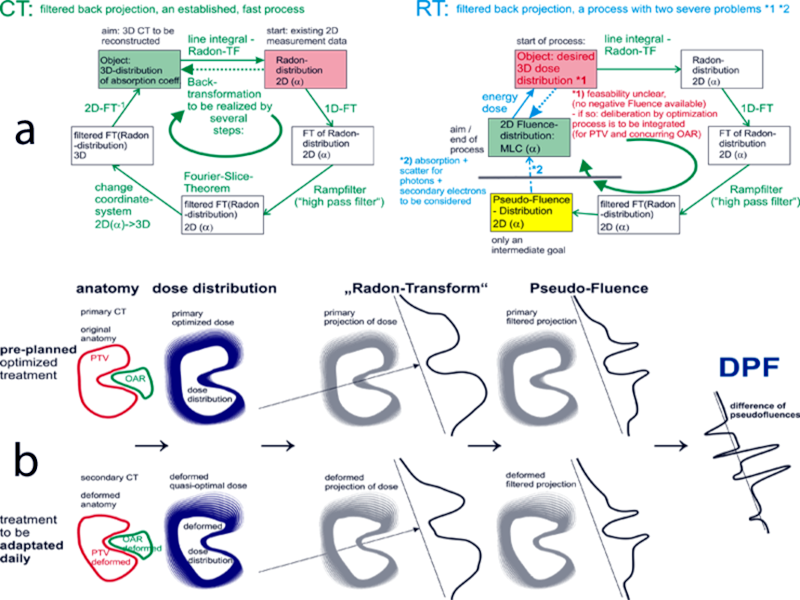Radon-transformation and filtered back-projection - a way to fast Ad-hoc VMAT-adaptation?
Klaus Bratengeier,
Germany
PO-1839
Abstract
Radon-transformation and filtered back-projection - a way to fast Ad-hoc VMAT-adaptation?
Authors: Klaus Bratengeier1, Kerstin Kirschbaum1, Bernadette Hahn2, Patrick Paulus3
1University Hospital Wuerzburg, Department of Radiation Oncology, Wuerzburg, Germany; 2Department of Mathematics, University of Stuttgart, Stuttgart, Germany; 3University Hospital Wuerzburg, Department of Radiation Oncology , Wuerzburg, Germany
Show Affiliations
Hide Affiliations
Purpose or Objective
Filtered back projection (FBP) of dose distributions to predict leaf motion to adapt a VMAT or IMRT plan to deformed PTV and OAR: Principal considerations.
Material and Methods
Contrary to CT, direct application of FBP for VMAT plans is not possible (Fig. 1.). #1 Negative fluences are not feasable, as for PTV doses without dose load to any OAR. #2 Scattering and absorption are not considered in the line integrals of the Radon transformation (RTF). Preliminary fluence distributions (Pseudo-Fluence, PF) have to be adjusted, also considering applicable machine parameters (MP).
For adaptation, obstacles #1 and #2 disappear almost completely because of usage of differences. The role of FBP is not to create dose distributions but to compare them. The primary dose distribution is generated by a treatment planning system, which includes the weighting (OARs, PTV) (#1), scattering and absorption, the MP (#2). The result is an applicable primary VMAT plan. A desired deformed dose distribution exists: Dose and related structures are pinned to the voxels that follow their displacement vectors.
We compare the primary and the desired adapted dose distribution, avoiding #1. We apply the concept of comparing their PF (Fig. 1a yellow). As the difference of PF (DPF) is used, many obstacles of type #2 are avoided (long range photon scatter, relative absorption effects, machine parameters). (See Fig. 1b).
For a first illustration, this concept was applied to a phantom case with subsequently added deformations (2nd plan). The primary plan was further optimized to the deformed structures and the difference of beam fluence (MU-weighted openings, DLP) is shown.
Fig. 1 a): filtered back projection utilized for CT and RT side by side. Obstacles *1 and *2 prevent from direct use in RT. b) Scheme for difference of pseudofluences (DPF) as predictors for adaptive leaf shifts.

Results
For a phantom containing a PTV partially enclosing an OAR, two 2-arc VMAT were created. The TPS system Pinnacle3 calculated a primary and a recalculated plan for the deformed situation. They differed clearly by their dose distributions, PF and MLC-positions. DPF and DLP were calculated for all gantry angles. A direct comparison shows strong correlation between DLP and prediction by DPF. DPF is blurred, presumably by short-rang electron scatter.
Fig. 2: VMAT 2 arcs, BEV 0°; left: DPF (yellow: negative, blue: positive values) - middle: DLP (yellow: leafs closed, blue: leafs opened) – right: 2D cross correlation.

Conclusion
For the first case, DPF seems to be a reliable predictor for adaptive leaf position changes (DLP). However, the correlation must be evaluated quantitatively - for many complex cases. In a second step, prediction rules have to be established and the reliability of the procedures has to be investigated. Control mechanisms could be part of the DPF-DLP-comparison. Then, FBP could prepare the way for very fast adaptive processes, like for early CT.